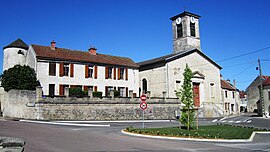Sainte-Colombe-sur-Seine
Sainte-Colombe-sur-Seine | |
|---|---|
 The church in Sainte-Colombe-sur-Seine | |
| Coordinates: 47°52′21″N 4°32′31″E / 47.8725°N 4.5419°E | |
| Country | France |
| Region | Bourgogne-Franche-Comté |
| Department | Côte-d'Or |
| Arrondissement | Montbard |
| Canton | Châtillon-sur-Seine |
| Intercommunality | Pays Châtillonnais |
| Government | |
| • Mayor (2020–2026) | Cyril Mayer[1] |
Area 1 | 16.16 km2 (6.24 sq mi) |
| Population (2022)[2] | 919 |
| • Density | 57/km2 (150/sq mi) |
| Time zone | UTC+01:00 (CET) |
| • Summer (DST) | UTC+02:00 (CEST) |
| INSEE/Postal code | 21545 /21400 |
| Elevation | 206–283 m (676–928 ft) (avg. 215 m or 705 ft) |
| 1 French Land Register data, which excludes lakes, ponds, glaciers > 1 km2 (0.386 sq mi or 247 acres) and river estuaries. | |
Sainte-Colombe-sur-Seine (French pronunciation: [sɛ̃t kɔlɔ̃b syʁ sɛn], literally Sainte-Colombe on Seine) is a commune in the Côte-d'Or department in eastern France.
Population
[edit]| Year | Pop. | ±% |
|---|---|---|
| 1962 | 1,245 | — |
| 1968 | 1,230 | −1.2% |
| 1975 | 1,330 | +8.1% |
| 1982 | 1,201 | −9.7% |
| 1990 | 1,151 | −4.2% |
| 1999 | 1,042 | −9.5% |
| 2008 | 895 | −14.1% |
Iron Age and Antiquity
[edit]Located not far from the site of the Vix grave, Sainte-Colombe is on a very rich archaeological territory. In the 19th century, several Hallstatt-era burial mounds containing wagon burials were excavated at the request of Napoleon III. The first, located at a place called La Garenne, provided in 1846 a magnificent bronze lebes of Etruscan origin,[3] now displayed in the Musée du Pays Châtillonnais in Châtillon-sur-Seine. In another, at La Butte, gold bracelets and earrings were discovered in the grave of a woman laid to rest on an iron-clad funerary wagon.[4][5] These gold items are now kept at the National Archeological Museum in Saint-Germain-en-Laye.
In the middle of the twentieth century René Joffroy (1958) postulated that the elites buried under the tumulus of La Butte and La Garenne had Mont Lassois as their place of residence. However geomagnetic surveys carried out in 2015 revealed the presence of several large buildings in the vicinity of the Sainte-Colombe burial mounds, suggesting that they may have also lived nearby.[6]
-
Etruscan lebes cauldron
-
Gold bracelets, 6th century BC
-
Gold earrings, 6th century BC
The remains of several Gallo-Roman villas were discovered in 1851.[7] Part of a mortuary column representing Venus and a sculpture of a draped woman discovered in 1867 are now kept in the Musée du pays Châtillonnais.[8]
See also
[edit]External links
[edit]References
[edit]- ^ "Répertoire national des élus: les maires". data.gouv.fr, Plateforme ouverte des données publiques françaises (in French). 9 August 2021.
- ^ "Populations de référence 2022" (in French). The National Institute of Statistics and Economic Studies. 19 December 2024.
- ^ Joffroy, René (1960). "Le bassin et le trépied de Sainte-Colombe (Côte-d'Or)". Monuments et mémoires de la Fondation Eugène Piot.
{{cite journal}}: CS1 maint: numeric names: authors list (link) - ^ Olivier, Laurent (2018). "Early Iron Age gold jewellery: 150 years of discoveries in France". Early Iron Age Gold in Celtic Europe; Society, Technology and Archaeometry. pp. 11–42. ISBN 978-3-89646-876-5.
- ^ Marie-France Saichet-Perbet (2004). "Sainte-Colombe-sur-Seine : Regards sur mon village". Châtillon-sur-Seine, Images du Châtillonnais. p. 120. ISBN 2-9521591-0-6.
- ^ Chaume, Bruno; Ballmer, Ariane; Della Casa, Philippe; Nieszery, Norbert; Pertlwieser, Thomas; Reinhard, Walter; Schäppi, Katharina; Urban, Otto; Winkler, Alexandra (July 2021). "Entre l'État et la chefferie simple: le complexe aristocratique de Vix/le mont Lassois". Vix et le phénomène princier. ISBN 978-2-35613-360-1.
- ^ René Paris (1987). "A la rencontre du Châtillonnais: Montigny-sur-Aube, Recey-sur-Ource, Châtillon-sur-Seine". La Bourgogne.
- ^ Marie-France Saichet-Perbet (2004). "Sainte-Colombe-sur-Seine : Regards sur mon village". Châtillon-sur-Seine, Images du Châtillonnais. p. 106. ISBN 2-9521591-0-6.







